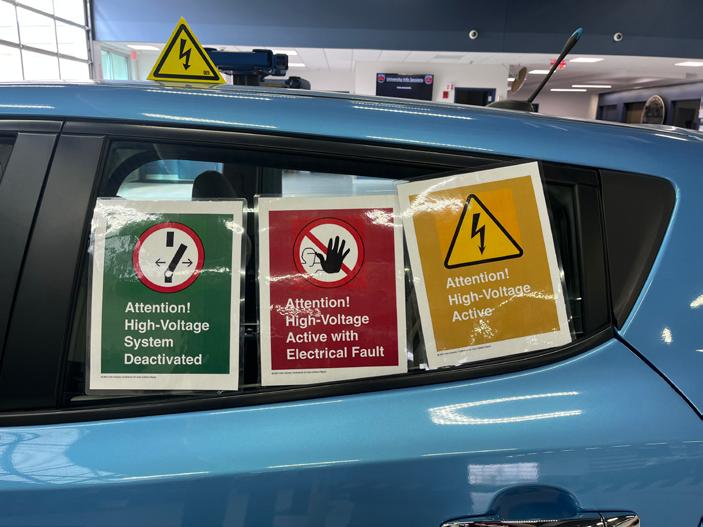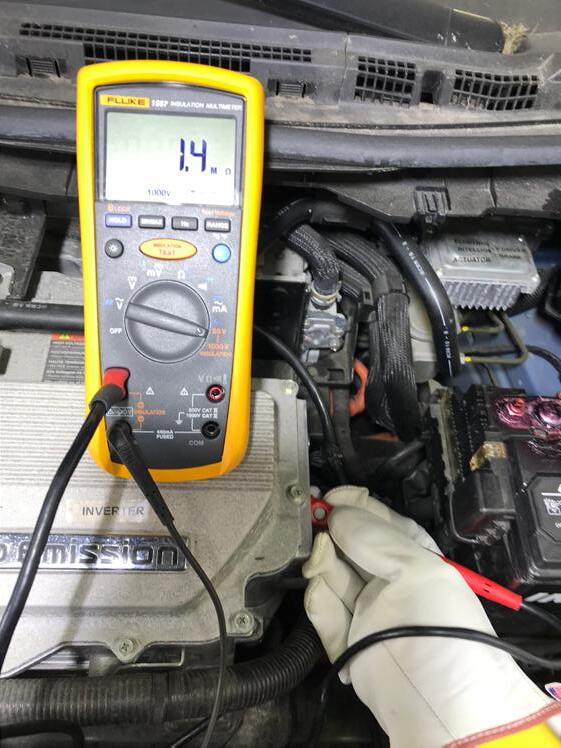
6 minute read
October 2023 Hybrid & Electric Vehicle Corner
by NACATNews
By Curt Ward, Professor at Joliet Junior College
The ASE xEV Level Two High-Voltage Technician Safety Exam
As I write this article the fall semester is in full swing. Our enrollment is back to pre-pandemic levels and the employment prospects for our students have never looked better. Earlier this year, ASE announced a series of safety exams that center on electric vehicle safety. I had the opportunity to take the level two exam, and I believe the content is exactly what the industry needs to understand. In this article I will discuss the content areas of the exam and why it is so important that an instructor who is going to teach hybrid and electric vehicles understand the subject.
Currently ASE has two safety exams available for registration. The level 1 exam is intended for the electrically aware person. People who should take this exam include service managers, service writers, or anyone else who is going to be around electric vehicles. The level 2 exam is intended for those who have received high-voltage training and have skills to repair electrically powered high-voltage vehicles. It specifically targets the areas of repair that require personal protective equipment. The exam is taken online and requires a passing grade of 80 percent. If successful, the certification is valid for three years. Visit www.ase.com/ev to register for the exams.
The level two exam covers twenty content areas. Personal protective equipment and understanding the risks related to working around high voltage is a significant part of the exam. Topics include class “0” gloves, safety glasses or face shield, and arc flash clothing. Also, in this section is the inspection and testing of high voltage safety gloves. Additionally, this section has a question on an insulated retrieval hook. Some manufacturers have specified these as a required special tool. There are also questions related to physical barriers and signage that should be placed on and around the vehicle being worked on. The barriers should be placed in a manner that will keep foot traffic away from the vehicle being worked on and the signage is used to make sure everyone is aware of the current state of the high voltage system. See Figure 1 for the signage we use at JJC. There are questions related to arc flash and arc blast. Although the probability of either of these conditions occurring when working on a vehicle is low, it is important to understand anytime we are working with voltages more than 400 volts we need to understand both concepts.

In the area of equipment, there are questions related to insulated tools, multimeters, and insulation testers. Insulated tools should be used to limit the risk when working on or around high voltage circuits. They should be inspected for damage prior to each use, and they should be discarded if any damage is noted. Only a category III multimeter, rated at 1000 volts, should be used when measuring high voltage circuits. A live-dead-live method of measurement should be used when verifying an absence of high voltage. This measurement method involves first measuring a known low voltage source, such as a 12-volt battery, to confirm the meter is working properly. The high voltage circuit is then measured to confirm no voltage is present.
Third, the known low voltage source is measured again to confirm the meter is still operating correctly after being connected to the high voltage circuit. The questions on insulation testers or megohm meters are related to the safe use of the meters. The purpose of these meters is to determine if the high voltage system has continuity to chassis ground. A properly operating high voltage system does not have continuity to chassis ground. Class 0 gloves with leather protectors should be worn when making these types of measurements. See Figure 2 for a loss of isolation test on a Nissan Leaf.

Several subject areas related to high voltage batteries are also covered on the exam. This includes the high and the low voltage disconnect methods of depowering the high voltage battery, the safety interlock circuit, high voltage capacitors, and the practice of lock-out/tag-out. Most of the vehicles in service today use a high voltage disconnect to isolate the battery for service. An increasing number of vehicles use a low voltage disconnect to disable the battery. See Figure 3 for a low voltage disconnect that has been locked out. Most electric vehicles have high voltage capacitors in the inverter. They provide additional energy when required and provide smoothing of the electrical current generated by the electric motors. Be familiar with the time required for the capacitors to discharge when depowering the high voltage system.

Any individual who has completed safety training and has practiced these tasks on a hybrid or electric vehicle should be able to pass the exam. It is important to remember that all the other safety items that we practice in our legacy classes and labs also apply in the high voltage setting as well. Check with your school’s insurance carrier; in many cases the completion of training, the passing of a certification test, and the proof of proper safety equipment is what is required for insurance coverage when working with these types of vehicles in the classroom or shop.
I will finish this article with the same offer I make after each of my presentations. If you are interested in getting started in the process of adding hybrid and electric vehicles to your curricuulum or want more information, please feel free to reach out. I am more than willing to sit down in-person or online and share my experiences. Are you looking for a classroom textbook? Reach out to Pearson and ask for a review copy of the all-new Electric and Hybrid Electric Vehicle text that Jim Halderman and I co-authored. It is a comprehensive text covering all the latest information on the subject.





